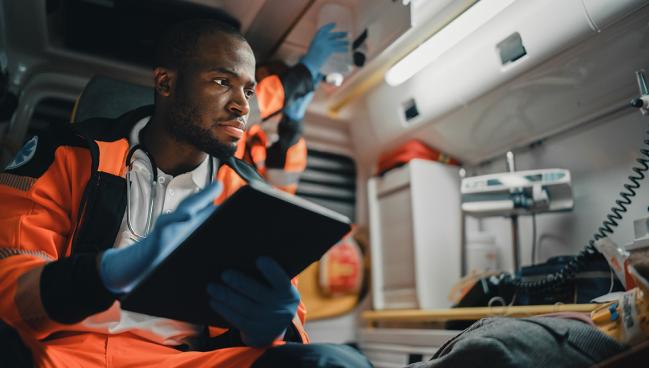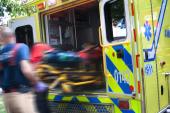Prehospital Cath Lab Activation in Australia Linked to Better STEMI Survival
The totality of data is strong enough that prehospital activation should be the standard in the US, says Timothy Henry.

Prehospital activation of the cardiac cath lab not only has a positive impact on performance measures, but also significantly improves both short- and long-term survival, according to new data from Australia.
In a standardized strategy among nearly 3,000 STEMI patients, those who received prehospital activation and went directly from the ambulance to the cath lab for primary PCI had a 30-day all-cause mortality rate of 1.6% and a 1-year all-cause mortality rate of 3.4%. By comparison, the rates were 6.6%and 10.2% for cases without prehospital activation (P < 0.001 for both).
In the paper, published July 18, 2023, in the Journal of the American Heart Association, Michael L. Savage, BAppSc (The Prince Charles Hospital, Brisbane, Australia), and colleagues say the findings strengthen a mixed bag of international data on the impact of prehospital notification of STEMI on mortality outcomes.
“Although the literature is predominantly supportive of lower mortality associated with prehospital activation strategies, recently published data were suggestive of no mortality benefit with a prehospital notification strategy,” Savage and colleagues write. “This study adds to the support for standardized prehospital strategies incorporating prehospital notification of STEMI, initiation of medical therapy, and activation of the cardiac catheterization laboratory to improve STEMI performance measures, reduce overall time to reperfusion, and lower short-and longer-term mortality.”
In the US, the National Cardiovascular Data Registry’s ACTION Registry has previously found that only about 40% of STEMI patients get prehospital activation, a number is probably overestimated, noted Timothy Henry, MD (The Christ Hospital, Cincinnati, OH), a co-author on that study.
To TCTMD, Henry said the mortality advantage isn’t surprising, adding that the Australian study adds to the totality of evidence showing that prehospital activation for STEMI patients provides overwhelming benefits. “There's strong enough data supporting prehospital activation that this should be the standard in our country,” he said. “The data from every single preactivation study has been in the right direction and there's no downside to doing it.”
One argument against the practice is that it could result in false identification of STEMIs and needless activation of the cath lab. However, Henry said that a standardized approach like the one used in the Australian study and the one developed by the American Heart Association's Mission: Lifeline Program—known as PreACT—gives paramedics a framework for communicating with emergency medicine and cardiology to determine eligibility for cath lab activation.
“It can be done safely and we know it can improve outcomes, with no or rare instances of false activations,” he added.
Standardizing Prehospital Care
Savage and colleagues examined mortality in 2,498 consecutive STEMI patients (mean age 62.2 years; 20% female) who were transported by ambulance to one of eight participating centers and underwent primary PCI over a 4-year period from 2017 through 2020.
The specific prehospital strategy used in the study involved:
- Paramedic-administered ECG within 10 minutes of first medical contact
- Paramedic interpretation of the ECG with a standardized checklist
- Non-PCI facility bypass for suspected STEMI
- Telephone consult and PCI referral to an interventional cardiologist on call
- Prehospital medication administration at time of referral acceptance
- Cath lab activated by an interventional cardiologist only
- An on-call team available within 30 minutes of activation
- Direct transfer to the cath lab at hospital arrival, bypassing the emergency department
Prehospital activation occurred in 1,832 patients. These patients received a standardized regimen of aspirin 300 mg orally plus ticagrelor 180 mg orally or clopidogrel 600 mg orally and heparin (unless contraindicated) from treating paramedics immediately post-PCI referral. Those with no prehospital activation did not receive these medications until they were evaluated in the emergency department. Compared with those with no prehospital activation, more patients in the activation group were male and had dyslipidemia.
The median door-to-balloon (DTB) time was 34 minutes in those with prehospital activation and 86 minutes in those without. The preactivation group had higher likelihood of achieving a DTB time under 60 minutes (90% vs 16%) as well as first medical contact-to-balloon (43% vs 8%) and first diagnostic ECG-to-balloon (62% vs 33%) times of less than 90 minutes (P < 0.001 for all).
In addition to lower all-cause mortality, the prehospital activation group also had lower CV mortality rates at 1 year than the group with no activation (2.6% vs 8.6%; P < 0.001).
After adjustment for factors strongly correlated with mortality, patients who did not have prehospital activation remained at increased risk of all-cause mortality at 30 days and 1 year and at higher risk of CV mortality at 1 year.
The data from every single preactivation study has been in the right direction and there's no downside to doing it. Timothy Henry
Savage and colleagues say the prehospital medical therapy provided by the paramedics “may explain, in conjunction with lower time to reperfusion, the association with lower mortality with prehospital activation in our study compared with previously published Australian literature.” However, they say it is unclear “whether the timing of initiation of medical therapy, including antithrombotic medication may also contribute to the mortality differences.”
To TCTMD, Henry said while the rate of prehospital activation for STEMI will never be 100% for a variety of patient-related reasons, it is reasonable that it could be as high as 65% to 75% in the United States if standardized strategies are carefully followed.
“I think it's achievable in well-run STEMI systems, but it takes work. You have to have agreement with your paramedics, your emergency room physicians, and your interventional cardiologists that this is the policy, and do it every time,” he said.
Henry added that while a prehospital strategy for STEMI does place more work on paramedics, all the published evidence suggests it is not only doable, but also works extremely well.
“The key point is that if you use criteria like what is laid out in PreACT, for example, you have a standard [for] who you are going to take and more importantly, who you aren’t going to take,” he said.
L.A. McKeown is a Senior Medical Journalist for TCTMD, the Section Editor of CV Team Forum, and Senior Medical…
Read Full BioSources
Savage ML, Hay K, Vollbon W, et al. Prehospital activation of the cardiac catheterization laboratory in ST-segment-elevation myocardial infarction for primary percutaneous coronary intervention. J Am Heart Assoc. 2023; Epub ahead of print.
Disclosures
- Savage and Henry report no relevant conflicts of interest.





Comments